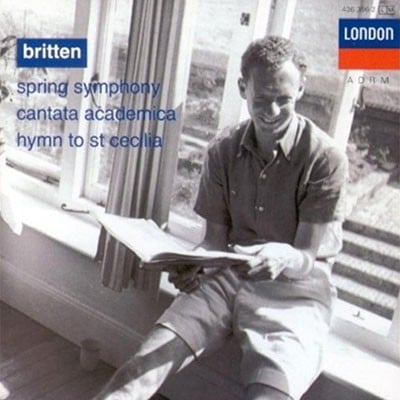Spring Symphony
op. 44 (1949)various (E)
3(III=afl,picc).2.corA.2.bcl.2.dbn-4.3.3.1-cow horn-timp.perc(4):
gong/t.bells/vib/xyl/cyms/cast/wdbl/BD/SD/tamb/TD-2harps-strings
Abbreviations (PDF)
Boosey & Hawkes
Commissioned by the Boston Symphony Orchestra, the Spring Symphony is, in Britten’s words, ‘a symphony not only dealing with the Spring itself but with the progress of Winter to Spring and the reawakening of the earth and life which that means’. A hybrid work – part symphony, part oratorio and part song-cycle – the large forces provide a flexible resource for a number of smaller combinations that change for each setting. Everyone comes together in the ‘May-day festival’ finale, crowned by the boys’ choir’s marvellously raucous rendition of the traditional English song, Sumer is icumen in.
Choral level of difficulty: Level 5 (5 greatest)
The Spring Symphony was commissioned by the Koussevitzky Music Foundation and is dedicated to Serge Koussevitzky and the Boston Symphony Orchestra. It was actually premiered at the Concertgebouw, Amsterdam in July 1949 before its American premiere the following month at Tanglewood by its dedicatees.
This work is a major undertaking from all points of view. It uses a huge orchestra (complete with cow horn which has to be hired specially), a children’s choir which certainly does not have to be composed only of boys, three soloists, and a large SATB chorus which is given very challenging and detailed music to sing. If any work demonstrates the flip side of the Britten coin from Saint Nicolas it must be the Spring Symphony. Here is a seriously intentioned, highly contemporary work for its time which nevertheless shows his predilection for anthologising texts, for creating amazing moments of levity – approaching the humorous episodes in his operas – and producing a score of such colour and vibrancy that the impression left on the mind is indelible. Despite being composed for an American ensemble and conductor this work is quintessentially British. The poems have strong connections with English pastoral imagery and some are forever associated with settings as madrigals. In fact this madrigalian emphasis bubbles gently beneath the surface for much of the work and points up where Britten’s roots really lie.
The work is divided into four parts – loosely the four movements of a symphony. The second part is nominally the ‘slow’ movement and the third might be thought of as the ‘scherzo’ but this shoehorning of his original structure into the standard formats is not entirely helpful. Britten actually sets each poem as a separate entity within each movement and simply moves on attacca into the next section. Thus the first part consists of five different sections each using varied forces and contributing to the colour and variety of the larger movement. The Introduction uses the full choir, The Merry Cuckoo is a tenor solo accompanied by three trumpets, Spring, the sweet spring uses all three soloists with choir, The Driving Boy is a tour-de-force for soprano and childrens’ choir (who also have to whistle!), The Morning Star is given to the chorus to end the first part, and so the work continues. The Finale is a genuine set piece and is the one movement which is composed to a single extended poem by Beaumont and Fletcher. Full of humour and high spirits – the entry of the cowhorn always raises a smile – it makes a wonderfully upbeat ending to this earthy work. The children’s choir is given a starring role throughout this amazing movement, but nowhere more so than at Britten’s inspired coup de théâtre where he brings in the well-known Sumer is icumen in at the end which crowns the sweeping choral phrases. And all this is in the brightest of keys – C major. The ending, as dramatic as everything which has preceded it fades away as the tenor soloist sings ‘...and so, my friends, I cease’ followed by a huge and final C major chord.
This is a challenging work on all fronts and is an extremely complex composition. It is however eminently performable by a choir of sufficient size to balance the large orchestra and who can rise to the level of attainment Britten requires. It also really does need a childrens’ choir – and a children’s choir which can sing with real confidence and projection. They are given a key role to play in this work. In fact the ‘spring’ element so vital to the whole concept is underscored by young singers in the ‘springtime’ of their lives. This, therefore, has to have a completely different kind of tone quality from the main choir – a second group of sopranos won’t do. Beyond these practical caveats this is a score which deserves to be better-known and more often performed than it is, and choirs and orchestras should be encouraged to promote it widely. It is one of the most original choral/orchestral works of the first half of the twentieth century.
Repertoire note by Paul Spicer

London Symphony Orchestra and Chorus/George Malcolm
(p) and (c) Decca Classics
Decca 475 6040
To purchase this CD from Amazon, click here now.

